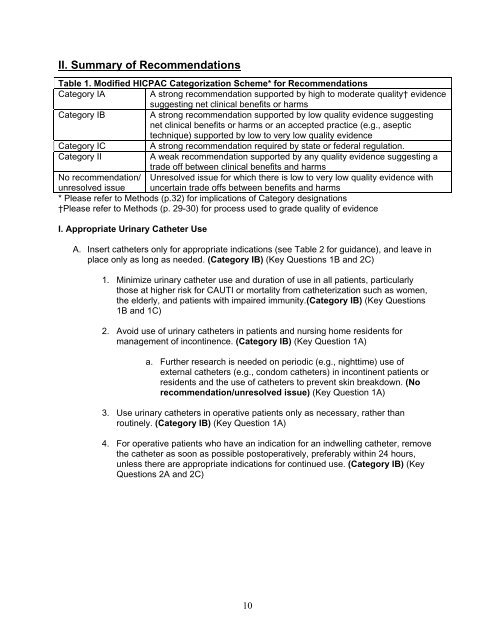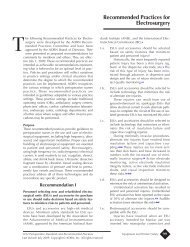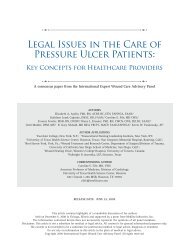2009 CAUTI guidelines - Centers for Disease Control and Prevention
2009 CAUTI guidelines - Centers for Disease Control and Prevention
2009 CAUTI guidelines - Centers for Disease Control and Prevention
Create successful ePaper yourself
Turn your PDF publications into a flip-book with our unique Google optimized e-Paper software.
II. Summary of RecommendationsTable 1. Modified HICPAC Categorization Scheme* <strong>for</strong> RecommendationsCategory IAA strong recommendation supported by high to moderate quality† evidencesuggesting net clinical benefits or harmsCategory IBA strong recommendation supported by low quality evidence suggestingnet clinical benefits or harms or an accepted practice (e.g., aseptictechnique) supported by low to very low quality evidenceCategory IC A strong recommendation required by state or federal regulation.Category IIA weak recommendation supported by any quality evidence suggesting atrade off between clinical benefits <strong>and</strong> harmsNo recommendation/ Unresolved issue <strong>for</strong> which there is low to very low quality evidence withunresolved issue uncertain trade offs between benefits <strong>and</strong> harms* Please refer to Methods (p.32) <strong>for</strong> implications of Category designations†Please refer to Methods (p. 29-30) <strong>for</strong> process used to grade quality of evidenceI. Appropriate Urinary Catheter UseA. Insert catheters only <strong>for</strong> appropriate indications (see Table 2 <strong>for</strong> guidance), <strong>and</strong> leave inplace only as long as needed. (Category IB) (Key Questions 1B <strong>and</strong> 2C)1. Minimize urinary catheter use <strong>and</strong> duration of use in all patients, particularlythose at higher risk <strong>for</strong> <strong>CAUTI</strong> or mortality from catheterization such as women,the elderly, <strong>and</strong> patients with impaired immunity.(Category IB) (Key Questions1B <strong>and</strong> 1C)2. Avoid use of urinary catheters in patients <strong>and</strong> nursing home residents <strong>for</strong>management of incontinence. (Category IB) (Key Question 1A)a. Further research is needed on periodic (e.g., nighttime) use ofexternal catheters (e.g., condom catheters) in incontinent patients orresidents <strong>and</strong> the use of catheters to prevent skin breakdown. (Norecommendation/unresolved issue) (Key Question 1A)3. Use urinary catheters in operative patients only as necessary, rather thanroutinely. (Category IB) (Key Question 1A)4. For operative patients who have an indication <strong>for</strong> an indwelling catheter, removethe catheter as soon as possible postoperatively, preferably within 24 hours,unless there are appropriate indications <strong>for</strong> continued use. (Category IB) (KeyQuestions 2A <strong>and</strong> 2C)10
















